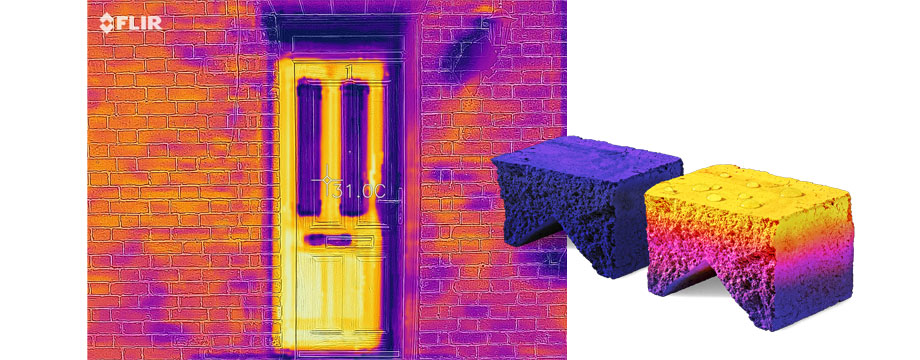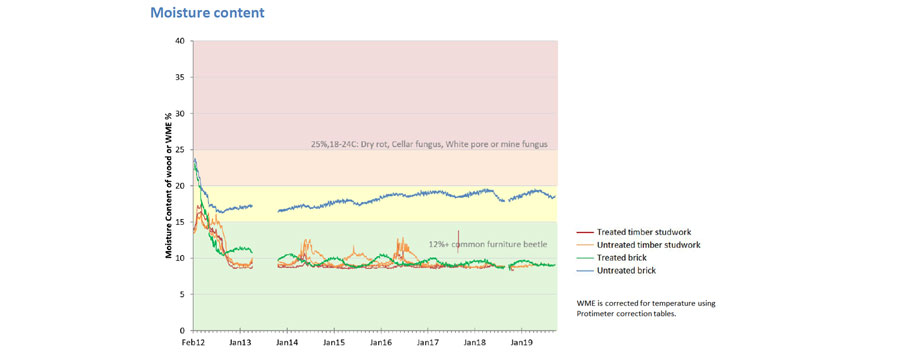How shielding insulation with Stormdry Masonry Cream can help save energy
Safeguard Europe, experts in waterproofing, have developed a series of Webinars that are completely free to attend. These offer both technical and practical advice on moisture management in buildings. One of these webinars is focused around the causes & treatment of penetrating damp, which will only become more prevalent in the coming years. With the help of the Association for Environment Conscious Building and Simmonds Mill Architects, they carried out a case study in a bid to develop an easy solution to help protect vulnerable homes from heavy rainfalls.
As part of the UK Government’s aspirations to become carbon neutral by 2050, measures are being put in place to tackle carbon emissions from properties. London’s homes and workplaces account for 78% of the capital’s carbon emissions[1], which points to the ever-growing need to address energy wastage from inefficient buildings. One of the ways property developers will achieve this is through optimising building performance via repair, installation and maintenance of Retrofit. This will reduce energy usage through robust insulation and carbon emissions as a result of demolition.

Images: 1 & 2
The Department for Business, Energy & Industrial Strategy claim that the size of heating systems can be reduced through maximising the performance of the components and materials that make up the building fabric and retrofitting itself, which comprise up to 60% of the total energy demand of a dwelling[2]. As walls are the biggest exposed area in a building, the improvement of their insulation level can have a significant impact in the retrofit of a building, thus retaining and enhancing their thermal properties.
The installation of Retrofit Internal Wall Insulation (IWI) is a great solution to retaining significant levels of heat in solid walls, however it presents some technical challenges which need managing. In particular, there is a high risk of condensation and mould growth:
‘When internal insulation is applied, the hygrothermal characteristics of the building may change and moisture management is therefore a major consideration for the installation of internal wall insulation and systems. Saturated brickwork will take significantly longer to dry out once IWI has been installed so there is a need to get saturation level down before installation commences. Consider the use of breathable brick cream once moisture content has been lowered[3]’.
Safeguard Europe, the UK’s leading developer in damp-proofing materials, have developed breathable brick cream to address this issue. Stormdry provides protection from penetrating damp whilst also maintaining the insulative properties of the structure it is applied to. Safeguard Europe partnered with the Association for Environment Conscious Building and Simmonds Mill Architects to put their Stormdry cream to the test, in a bid to see just how effective a waterproofing masonry treatment is at reducing the moisture content in solid walls. Has a solution for the costly hindrance of penetrating damp finally been found?

Image: 3
In 2012, Safeguard Europe, the Association for Environment Conscious Building and Simmons Mill Architects carried out a comparative scientific case study involving the effects of rain penetration on internal wall insulation. The moisture in a solid brick wall with a waterproofing masonry cream was monitored against the same brick wall with no surface treatment.
The guinea pig was a 19th century brick and stone solid-wall house with internal retrofit insulation in rural Herefordshire. One half of the property was treated with Stormdry Masonry Cream, and the other half left untreated. The aim was to monitor the moisture in both the treated and untreated half of the building to determine mould and timber decay risk over an extended period of time. Omnisense battery-powered data loggers were placed around the building to measure the temperature and moisture intake of the brick, and left to work their magic.
Eight years later, the Safeguard Team gathered the data and examined the results. In the untreated wall, the moisture content at the internal wall surface increased to 20% over 8 years - whereas for the treated wall, it was dramatically reduced to 9% over the same time frame. Even the predicted condensation in the winter months failed to manifest. The dew point on the treated wall was not reached, keeping the wall warm.
Humidity is another key factor in keeping damp at bay, as this will determine at what point liveable conditions for black mould will be present. The latest government statistics show that around 3.5% of all UK dwellings will suffer from some type of dampness during their lifespan. Penetrating damp is the most costly, as it first requires any defects to be fixed, followed by remedying the damp itself. On average, it will cost around £100 to replace one roof tile, and £500 to replace a casement window. In the Herefordshire property, there were numerous defects such as cracks, gaps and deterioration of brickwork. Even so, after the application of Stormdry, the humidity on the treated walls remained below 80% for the duration of the 8 years, succeeding in inhibiting mould growth by allowing trapped moisture to evaporate through its breathable formula.
With the UK’s energy system plunged into chaos by a perfect storm of market upheavals, impending threats of energy suppliers collapsing followed by unaffordable bills, there is an ever-growing need for an efficient, cost-effective treatment which can withstand worsening weather conditions across the country. Climate change has played a cumulative role in increasing the moisture load on buildings, particularly in the form of persistent rainfall and heavy rain days, which increases the water saturation in solid walls due to the lack of drying spells. With nearly a third of UK houses built from solid walls, penetrating damp has become a prevalent issue which will only keep snowballing as these rainfalls intensify. Despite the integration of solid wall insulation systems such as insulated plaster, flexible thermal lining, or insulation boards, which were found to increase the moisture content of the exterior wall, penetrating damp is still a major problem.

Image: 4
The Ministry of Housing, Communities & Local Government consequently determined that solid walls with Internal Wall Insulation were one of the riskiest insulation methods, the main risk being from penetrating rain[4]. With the number of insulation retrofit installations increasing as part of the UK government target to reach zero emissions by 2050 from all use in buildings, Stormdry Masonry Protection Cream is the perfect aid against the ever-growing financial and energy supply crisis, offering a green, affordable method for protecting your abode from the worst of the weather.
[1] https://www.london.gov.uk/what-we-do/environment/energy/energy-buildings#:~:text=As%20homes%20and%20workplaces%20account,to%20cut%20costs%20and%20carbon.
[2] https://www.google.com/url?q=https://www.gov.uk/government/publications/retrofit-internal-wall-insulation-best-practice&sa=D&source=docs&ust=1634893912192000&usg=AOvVaw3qKCkpB9Hgp5bIP2wYvRkx
[3] https://www.gov.uk/government/publications/resistance-to-moisture-in-buildings
[4] https://www.gov.uk/government/publications/resistance-to-moisture-in-buildings
Images:
1. Thermal image of heat escaping through the property door
2. Thermal resistance of bricks using Stormdry Masonry cream
3. Comparative scientific case study on 19th century brick and stone solid-wall house
4. Moisture content data gathered after eight years
- Log in to post comments















